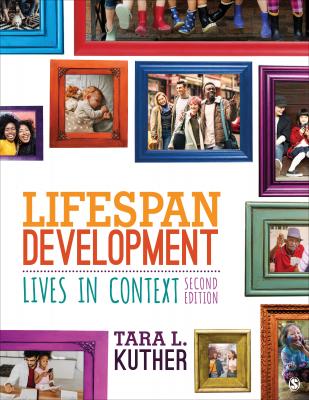ТОП просматриваемых книг сайта:
Lifespan Development. Tara L. Kuther
Читать онлайн.Название Lifespan Development
Год выпуска 0
isbn 9781544332253
Автор произведения Tara L. Kuther
Издательство Ingram
Critical Thinking
Critical Thinking Questions: At the end of each main section within the chapter, these Thinking in Context critical thinking questions encourage readers to compare concepts, apply theoretical perspectives, and consider applications of research findings presented.
Boxed Features: Each boxed feature appears in every chapter and concludes with critical thinking questions that challenge students to assess and evaluate the issues highlighted in that feature. The boxed features exemplify the applied, contextual, and research-based theme of Lifespan Development: Lives in Context:
Lives in Context
Applying Developmental Science
Cultural Influences on Development
Brain and Biological Influences on Development
Case-Based Application: Each chapter closes with a case scenario, Apply Your Knowledge, followed by in-depth questions that require students to apply their understanding to address a particular situation or problem.
Supplements
Original Video
Lifespan Development in Context, Second Edition, is accompanied by a robust collection of Lives in Context Video Cases that demonstrate key concepts through real-life examples, as well as Dr. Kuther’s Chalk Talks, a series of whiteboard-style videos carefully crafted to engage students with course content. All videos are accessible through the interactive eBook available to pair with the text.
For Instructors
SAGE edge is a robust online environment featuring an impressive array of tools and resources. At edge.sagepub.com/kuther2e, instructors using this book can access the password-protected customizable PowerPoint slides, along with an extensive Test Bank built on Bloom’s taxonomy that features multiple-choice, true/false, essay, and short answer questions for each chapter. The instructor’s manual is mapped to learning objectives and features lecture notes, discussion questions, chapter exercises, class assignments, and more.
For Students
Free resources are available at http://edge.sagepub.com/kuther2e to promote mastery of course material. Students are encouraged to access articles from award-winning SAGE Journals, listen to podcasts, and watch open-access video resources. Students can then practice with mobile-friendly Flashcards and Quizzes to find out what they’ve learned. The text can also be paired with an interactive eBook that offers one-click access to these study tools and to the book’s Original Video package for a seamless learning experience.
What’s New in Lifespan Development: Lives in Context, Second Edition?
I approached writing the second edition of Lifespan Development: Lives in Context with three goals:
1 Increase the coverage of context, including ethnic, cultural, and socioeconomic diversity.I addressed this goal by adding findings and sections covering contextual and cultural influences throughout each chapter. For example, the Cultural Influences on Development feature in each chapter speaks to the role of cultural factors in development.
2 Update the text to include the most current research to date.Our knowledge of human development is rapidly expanding. My goal was to select, highlight, and integrate cutting-edge research findings with existing theory and research. The second edition includes over 1,400 references published since 2016, including nearly 900 published in 2017 and 2018.
3 Streamline the text.My goal for this second edition was to paradoxically increase coverage of current research while increasing concision. This goal is influenced by my observations of my own students’ use of this text. I approached this goal by carefully considering each section of each chapter and painstakingly paring down the verbiage and excess detail while retaining and enhancing the scientific basis for conclusions. As a result, each chapter is shorter with streamlined, but not reduced, coverage of the major findings in developmental science. I have also sharpened the chapter learning objectives and summaries.
Below I list the major revisions reflected in this second edition of Lifespan Development: Lives in Context. It is my hope that this volume will improve instructors’ and students’ experiences in and out of class—and that students will be inspired to apply the findings of developmental science to their lives.
Chapter 1
Updated What Is Lifespan Human Development?, including Development Is Multidimensional, Development Is Multidirectional, and Development Is Plastic
Added new coverage of age-graded influences, history-graded influences, and nonnormative influences to Development Is Influenced by Multiple Contexts
Updated and revised Cultural Influences on Development: Defining Culture
Updated Basic Issues in Lifespan Human Development, including Continuities and Discontinuities in Development, Individuals Are Active in Development, and Nature and Nurture Influence Development
Updated coverage and evaluation of Freud’s Psychosexual Theory
Updated Operant Conditioning, Piaget’s Cognitive-Developmental Theory, and Information Processing Theory
Updated and expanded coverage of Ethology and Evolutionary Developmental Theory
New Applying Developmental Science: The Real-World Significance of Developmental Research, highlighting the ethical issues that arise in developmental science and its implications for international policy
New coverage of Physiological Measures
New feature on Brain and Biological Influences on Development: Methods of Studying the Brain
Added new research examples of Experimental Research
Chapter 2
Updated coverage and streamlined Cell Reproduction
Updated coverage of Ethical and Policy Applications of Life Span Development: Prenatal Sex Selection and retitled as Applying Developmental Science: Prenatal Sex Selection
Updated coverage of Genes Shared by Twins
Updated and extended coverage of Dominant–Recessive Inheritance to include additional information about sickle cell trait
Updated and expanded coverage of Genomic Imprinting
Updated coverage of Dominant–Recessive Disorders
Updated and reorganized coverage of X-Linked Disorders
Updated and expanded coverage of Chromosomal Abnormalities
Updated coverage of Mutation
New section: Genetic Counseling with new subsections on Reproductive Technology and Adoption
Updated and expanded coverage of Prenatal Testing to include fetal MRI
Updated and expanded coverage of Prenatal Treatment of Genetic Disorders to include fetoscopy
Updated coverage of Behavioral Genetics, including Genetic Influences on Personal Characteristics, Gene–Environment Interactions, Canalization, and Gene–Environment Correlations
Updated coverage of Epigenetic Influences on Development replaces Epigenetic Framework
Updated Applying Developmental Science: Altering the Epigenome

